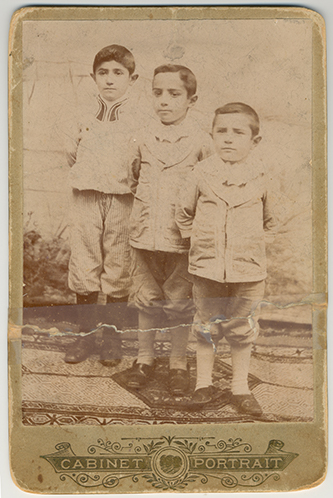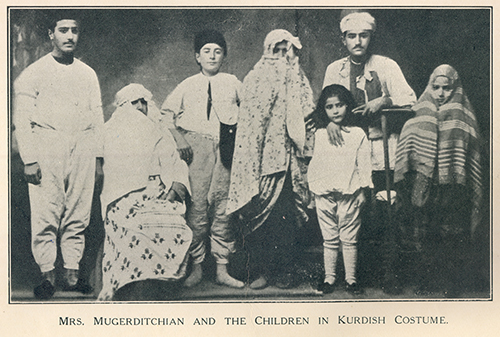
The Mkrtchyan family was from the town of Mezre in the Kharberd province of Western Armenia. Tovmas and Yester Mkrtchyan had six children: Yervand, Zenob, Arsen, Araxi, Armine and Alis. The father of the family, Tovmas Mkrtchyan, was a protestant pastor who, from 1896, worked in the service of the British Eastern Consulate in Egypt, which enabled him to avoid arrest and exile.
The deportation order for the Kharberd Armenians was issued in June 1915. Widespread searches, arrests, looting and torture all started under the pretext of finding weapons. Yester and her children managed to find shelter in a local American missionary building.
One day the order for “exile” paper was posted on the Mkrtchyans’ house. Yester remembered how the police and the neighboring Turkish women mercilessly looted their belongings of many years. She appealed to the German consulate representative in Kharberd for help, but after receiving a refusal, she desperately applied to the kaymakam. The latter’s demand for conversion was flatly rejected by Yester. She managed to persuade the kaykamakam’s wife to mediate with her husband to replace the requirement of conversion with a sum of money. With the help of the missionaries, the necessary money was collected.
Disguised as a Kurdish woman, Yester, with Arsen, Alice and little Armine, hid in a hospital in Mezre, while Yervand and Zenob locked themselves in a two-and-a-half-meter deep cellar under their house. Turkish police surrounded the hospital building under the pretext of finding Armenians and searched it. There were Armenian women and children hiding here, many of whom had been sheltered by a hospital doctor after learning of the Turks’ intentions. Yester, however, failed to hide. She was arrested but was soon released through the mediation of the American consul.
Overcoming many trials, including a typhoid epidemic (which afflicted Araxi and Zenob) Yester arrived with her children in Dersim, and then went to Erzurum, from where she migrated to Tbilisi (Georgia). Deprived of basic necessities, Yester temporarily put her children in the care of an orphanage and tried to raise money. After some time, they sailed to Liverpool in Great Britain and went from there to the USA. The Mkrtchyan family, who miraculously survived the genocide, finally settled in the United States in 1919, where their descendants still live.
Yester Mkrtchyan’s [Esther Mugerditchian] book translated from Armenian “From Turkish Toils: The Narrative of an Armenian Family’s Escape,” published in London in 1918, is a primary source concerning the deportation and massacres of the Armenians of Kharberd.
Yester Mkrtchyan wrote:
“In total, more than 3,000 people were arrested, who were the cream of the Kharberd Armenians. Among those people was the Armenian spiritual leader of the Kharberd province, Archimandrite (vardapet) Psak. All of them were killed in the curving, snake-like, cursed gorge near Pagr-Maten. Some were doused in fuel and burned alive, others were killed with bullets, swords, axes and stones. Returning policemen who had accompanied them told of their crimes. They also described, with great amusement, about the brutal murder of the spiritual leader Rev. Psak, who had been hung by his legs from a tree, was flayed alive.”
Yester Mkrtchyan testified that her family was the only one in all of Kharberd who managed to survive the genocide without loss.
 Three sons of Tovmas and Yester Mkrtchyans’ (from left to right) Zenob, Yervand Arsen
Three sons of Tovmas and Yester Mkrtchyans’ (from left to right) Zenob, Yervand Arsen
Armenian Genocide Museum-Institute
 Esther Mugerditchian, “From Turkish Toils: The Narrative of an Armenian Family’s Escape,” London, 1918
Esther Mugerditchian, “From Turkish Toils: The Narrative of an Armenian Family’s Escape,” London, 1918
 Yester Mkrtchyan and her children in Kurdish Costume
Yester Mkrtchyan and her children in Kurdish Costume





